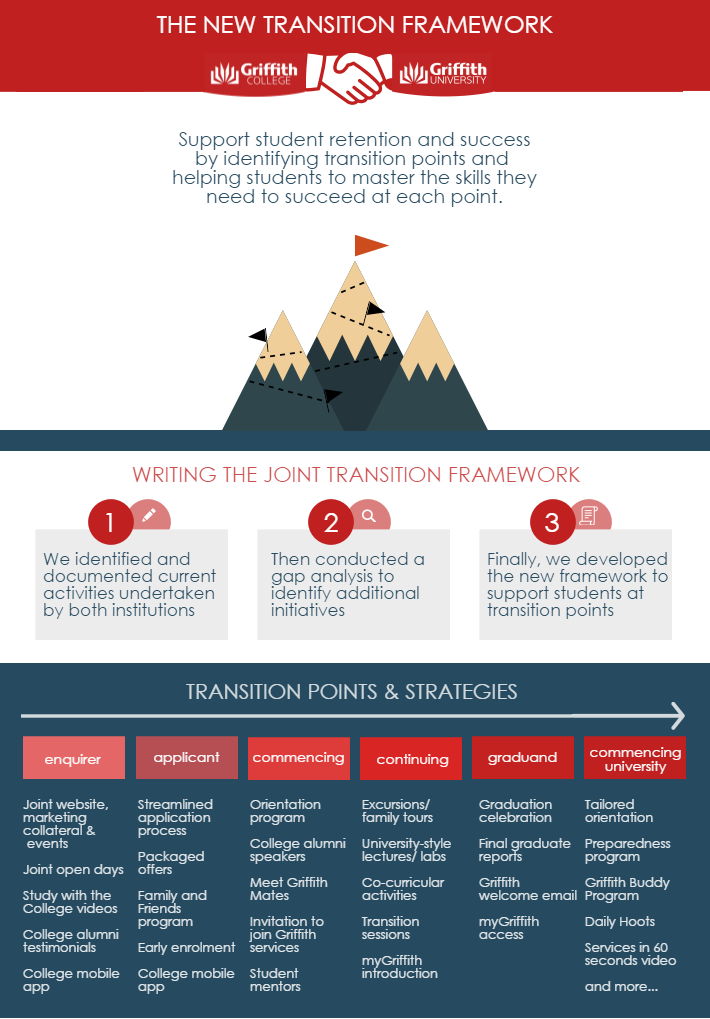Q&A Highlights: Helping students master the skills they need to transition

A new model for student retention and success has arisen from joint efforts by Griffith College and Griffith University, with an emphasis on helping students master the skills they need to transition through different phases of study.
You can watch the Q&A session here or jump to the visual summary.
Here are some of the paraphrased highlights:
How does your transition model address student retention?
Cultural transformations and massification of tertiary education have contributed to a “moral panic” about student retention (Gale and Parker, 2014). Myths abound in conversations about student retention, which current research is challenging; for example that first-in-family students translate to higher risk in terms of retention. A new understanding of student success needs to be advanced that focuses on the capacity of all students to master the discourses of higher education. Griffith College and Griffith University have worked together to build such a model, supporting students across their entire academic lifecycle.
Our new approach is to build a collaborative culture that helps students navigate their way to mastery of the skills they need to succeed across different phases of their learning.
Our mastery approach is informed by Lizzio’s (2006) Five Senses Model which advocates developing students’ sense of connectedness, capability, resourcefulness, purpose and culture by focusing on skill mastery; for example, to build a sense of capability, focus on academic competence, mastering task and role clarity or contributing to community.
What process did Griffith College and Griffith University go through to come up with this document?
Griffith College and Griffith University worked together to create the new Joint Transition Framework.
We track data on student performance and outcomes at both the College and University and we know from this data that Griffith College students perform at a comparable level to university direct-entry students. However, challenges do exist around student success specifically in the first semester following transition.
The joint working group reviewed existing approaches and undertook a gap analysis and review with current and recently graduated students identifying key opportunities to better support student success and transition. Beyond the obvious transition from college to university, a number of other important moment of transition were identified.
After identifying the key opportunities of transition in the student life cycle, strategies were reviewed and developed for each key stage. A range of new initiatives were added to the existing approaches to develop a comprehensive framework mapped across the whole lifecycle. The strategies highlight the strong partnership between the College and University and encourage students to master a sense of their own connectedness and capabilities.
Within the strategy, do you delineate between international and domestic students transitioning to the second year of their degree?
Not really. We found that students had the same concerns regardless of their status as international or domestic students, in our current state and gap analyses. So, we support everyone in mastering the skills they need at each point of transitions.
In the past, we had specific initiatives for international students, such as orientation sessions tailored with advice on culture and government study regulations. However, the feedback was that the students wanted to make new friends, and particularly Australian friends. So, students don’t want to be grouped on difference, they want to be treated all the same.
How do you cost all these initiatives? Are stakeholders absorbing the costs or are they absorbed into day-to-day operations?
Some initiatives are already part of the day-to-day operations in both institutions.
As we developed the framework, we made a decision to develop the framework first, gain endorsement from stakeholders that it met their needs and expected outcomes, and then look at costing each of the initiatives independently. Some initiatives will emerge as part of the current operations, but others that go beyond will be funded separately.
How do you measure how many students attend transition sessions or use your materials?
The focus on counting attendance in-person has diminished. More supports and services are available online now and we no longer emphasise one type of session or attendance.
Sometimes students are not aware that there are any learning or contextual differences between the College and University; a testament to the current supportive learning environment. Therefore, there is often a need to create a ‘shock’ to highlight the learning opportunities and awaken students to the need to engage with transition strategies.
Instead of shocking students into attending a face-to-face session, we are now making sure our materials, information and strategies are available ‘just-in-time’ for when these shocks occur, which are at different points for different students. With a suite of new online and mobile materials, we are encouraging them to access the information they need when they are in the right frame of mind to absorb it – when it is more relevant to their situation. In addition we are supporting this through individual meeting times, and the continuation of sessions delivered to cohorts of students around targeted issues.
The video conference is worth watching in full to hear directly from the Griffith College team about all the different transitions students journey through from the time they enrol to the time they matriculate and graduate.
This image summarises the new approach and strategies:

[Produced in collaboration with Georgie Lowe.]
To continue the conversation, connect with the panel members on Yammer, or email us at learningandteaching@navitas.com
- Ann Poiner, Director, Academic Programs & Student Services
- Matthew Campbell, Academic Program Convenor
- Mark L’Estrange, Senior Manager Academic & Student Administration
- Christopher Hassen, Student Experience Officer
